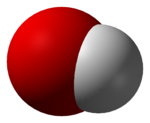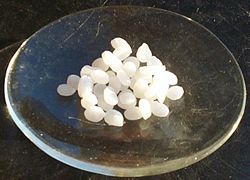Difference between revisions of "Hydroxide" - New World Encyclopedia
Andy Wilhelm (talk | contribs) (Copyedit) |
m |
||
| (6 intermediate revisions by 4 users not shown) | |||
| Line 1: | Line 1: | ||
| − | {{Copyedited | + | {{Copyedited}}{{Images OK}}{{Submitted}}{{Approved}}{{Paid}} |
<!-- Here is a table of data; skip past it to edit the text. —> | <!-- Here is a table of data; skip past it to edit the text. —> | ||
| − | {| | + | {|class="infobox" style="float:right;"margin:0 0 1em 1em;" border="1" cellspacing="0" cellpadding="3" style="margin: 0 0 0 0.5em; background: #FFFFFF; border-collapse: collapse; border-color: #C0C090;" |
! {{chembox header}} | Hydroxide | ! {{chembox header}} | Hydroxide | ||
|- | |- | ||
| Line 8: | Line 8: | ||
! {{chembox header}} | General | ! {{chembox header}} | General | ||
|- | |- | ||
| − | | [[IUPAC nomenclature|Systematic name]] | + | | [[IUPAC nomenclature|Systematic name]] |
| hydroxide<br/>oxidanide<br/>hydridooxygenate(1−) | | hydroxide<br/>oxidanide<br/>hydridooxygenate(1−) | ||
|- | |- | ||
| Line 23: | Line 23: | ||
|- | |- | ||
|} | |} | ||
| + | |||
| + | In [[chemistry]], '''hydroxide''' is the most common name for the [[diatomic]] [[anion]] OH<sup>−</sup>, consisting of [[oxygen]] and [[hydrogen]] [[atom]]s. It is one of the simplest diatomic ions known. The term "hydroxide" also refers to the class of compounds that contain the hydroxide ion. Common examples are [[sodium hydroxide]], [[potassium hydroxide]], and [[ammonium hydroxide]]. | ||
| + | {{toc}} | ||
[[Image:Sodium hydroxide.jpg|thumb|250px|Pellets of sodium hydroxide.]] | [[Image:Sodium hydroxide.jpg|thumb|250px|Pellets of sodium hydroxide.]] | ||
| + | Hydroxide compounds and ions are relatively common in nature. Several mineral ores, such as [[bauxite]] and [[limonite]], are hydroxides. In addition, hydroxides are widely used in human activities. For example, [[sodium hydroxide]] (lye) is useful as a strong base in industry, and [[potassium hydroxide]] is used in agriculture. | ||
| − | + | ==Hydroxide as a base== | |
| − | |||
| − | |||
| − | + | Most compounds containing the hydroxide ion are chemical [[base (chemistry)|base]]s. Thus, hydroxide ions are involved in numerous [[acid-base]] reactions, including the reaction known as [[neutralization]]. | |
| − | Most compounds containing hydroxide are | ||
| − | + | A substance that produces hydroxide ions when dissolved in [[aqueous solution]] is called an [[Arrhenius base]]. One example is [[ammonia]] (NH<sub>3</sub>): | |
:NH<sub>3</sub>(g) + H<sub>2</sub>O(l) {{unicode|⇌}} [[ammonium|NH<sub>4</sub><sup>+</sup>]](aq) + OH<sup>−</sup>(aq) | :NH<sub>3</sub>(g) + H<sub>2</sub>O(l) {{unicode|⇌}} [[ammonium|NH<sub>4</sub><sup>+</sup>]](aq) + OH<sup>−</sup>(aq) | ||
| − | + | Salts containing hydroxide are called [[base salts]]. Base salts will dissociate into a cation and one or more hydroxide ions in water, making the solution basic. Base salts will undergo [[neutralization reaction]]s with [[acid]]s. In general, an [[acid-alkali reaction]]s can be simplified to | |
| − | |||
| − | Salts containing hydroxide are called [[base salts]]. Base salts will dissociate into a cation and one or more hydroxide ions in water, making the solution basic. Base salts will undergo [[ | ||
:OH<sup>−</sup>[[Aqueous|(aq)]] + [[hydronium|H<sup>+</sup>]](aq) → [[water (molecule)|H<sub>2</sub>O]][[liquid|(l)]] | :OH<sup>−</sup>[[Aqueous|(aq)]] + [[hydronium|H<sup>+</sup>]](aq) → [[water (molecule)|H<sub>2</sub>O]][[liquid|(l)]] | ||
| − | + | Ions that do not participate in this reaction are called [[spectator ion]]s and are not shown here. | |
==Solubility== | ==Solubility== | ||
| − | Most inorganic hydroxide salts are [[insoluble]] in water | + | Most inorganic hydroxide salts are [[insoluble]] in water. Important exceptions are salts in which the cations are [[alkali metal]] ions and or [[Ammonium|NH<sub>4</sub><sup>+</sup>]], [[Barium|Ba<sup>2+</sup>]], [[Strontium|Sr<sup>2+</sup>]], [[Calcium|Ca<sup>2+</sup>]], or [[Thallium|Tl<sup>+</sup>]] ions. |
| + | |||
| + | ==Behavior as a ligand== | ||
| + | |||
| + | The hydroxide ion is a type of [[ligand]]. Each oxygen atom in the OH<sup>−</sup> ion has a "lone pair" (unshared pairs) of electrons in the outermost shell, and it forms bonds by donating this pair of electrons to an appropriate receiving atom. In this manner, a hydroxide ion behaves as a [[Lewis base]]. Examples include the aluminate ion [Al(OH)<sub>4</sub>]<sup>−</sup>, and aurate ion [Au(OH)<sub>4</sub>]<sup>−</sup>. | ||
==Uses of hydroxide== | ==Uses of hydroxide== | ||
| − | Hydroxides and hydroxide ions are relatively common. Many useful chemicals and chemical processes involve hydroxides or hydroxide ions. [[Sodium hydroxide]] (lye) is used in industry as a strong base, [[potassium hydroxide]] is used in agriculture, and [[iron hydroxide]] minerals such as [[goethite]] and [[limonite]] have been used as low grade ''brown'' iron [[ore]]. The [[ | + | Hydroxides and hydroxide ions are relatively common. Many useful chemicals and chemical processes involve hydroxides or hydroxide ions. [[Sodium hydroxide]] (lye) is used in industry as a strong base, [[potassium hydroxide]] is used in agriculture, and [[iron hydroxide]] minerals such as [[goethite]] and [[limonite]] have been used as low grade ''brown'' iron [[ore]]. The [[aluminum]] ore [[bauxite]] is composed largely of aluminum hydroxides. |
| − | |||
| − | |||
| − | |||
| − | |||
==See also== | ==See also== | ||
| − | |||
| − | |||
| − | |||
| − | + | * [[Base (chemistry)]] | |
| − | + | * [[Hydronium]] | |
| + | * [[Hydroxyl]] | ||
| + | * [[Oxide]] | ||
| + | * [[Sodium hydroxide]] | ||
== References == | == References == | ||
| − | + | * Chang, Raymond. 2006. ''Chemistry''. 9th ed. New York: McGraw-Hill Science/Engineering/Math. ISBN 0073221031 and ISBN 978-0073221038. | |
| + | * Cotton, F. Albert, and Geoffrey Wilkinson. 1980. ''Advanced Inorganic Chemistry''. 4th ed. New York: Wiley. ISBN 0471027758. | ||
| + | * McMurry, J., and R.C. Fay. 2004. ''Chemistry''. 4th ed. Upper Saddle River, NJ: Prentice Hall. ISBN 0131402080. | ||
[[Category:Physical sciences]] | [[Category:Physical sciences]] | ||
Latest revision as of 22:31, 30 August 2016
| Hydroxide | |
|---|---|

| |
| General | |
| Systematic name | hydroxide oxidanide hydridooxygenate(1−) |
| Molecular formula | OH− |
| Molar mass | 19.02 g/mol |
| CAS number | [14280-30-9] |
| Except where noted otherwise, data are given for materials in their standard state (at 25 °C, 100 kPa) Infobox disclaimer and references | |
In chemistry, hydroxide is the most common name for the diatomic anion OH−, consisting of oxygen and hydrogen atoms. It is one of the simplest diatomic ions known. The term "hydroxide" also refers to the class of compounds that contain the hydroxide ion. Common examples are sodium hydroxide, potassium hydroxide, and ammonium hydroxide.
Hydroxide compounds and ions are relatively common in nature. Several mineral ores, such as bauxite and limonite, are hydroxides. In addition, hydroxides are widely used in human activities. For example, sodium hydroxide (lye) is useful as a strong base in industry, and potassium hydroxide is used in agriculture.
Hydroxide as a base
Most compounds containing the hydroxide ion are chemical bases. Thus, hydroxide ions are involved in numerous acid-base reactions, including the reaction known as neutralization.
A substance that produces hydroxide ions when dissolved in aqueous solution is called an Arrhenius base. One example is ammonia (NH3):
- NH3(g) + H2O(l) ⇌ NH4+(aq) + OH−(aq)
Salts containing hydroxide are called base salts. Base salts will dissociate into a cation and one or more hydroxide ions in water, making the solution basic. Base salts will undergo neutralization reactions with acids. In general, an acid-alkali reactions can be simplified to
Ions that do not participate in this reaction are called spectator ions and are not shown here.
Solubility
Most inorganic hydroxide salts are insoluble in water. Important exceptions are salts in which the cations are alkali metal ions and or NH4+, Ba2+, Sr2+, Ca2+, or Tl+ ions.
Behavior as a ligand
The hydroxide ion is a type of ligand. Each oxygen atom in the OH− ion has a "lone pair" (unshared pairs) of electrons in the outermost shell, and it forms bonds by donating this pair of electrons to an appropriate receiving atom. In this manner, a hydroxide ion behaves as a Lewis base. Examples include the aluminate ion [Al(OH)4]−, and aurate ion [Au(OH)4]−.
Uses of hydroxide
Hydroxides and hydroxide ions are relatively common. Many useful chemicals and chemical processes involve hydroxides or hydroxide ions. Sodium hydroxide (lye) is used in industry as a strong base, potassium hydroxide is used in agriculture, and iron hydroxide minerals such as goethite and limonite have been used as low grade brown iron ore. The aluminum ore bauxite is composed largely of aluminum hydroxides.
See also
- Base (chemistry)
- Hydronium
- Hydroxyl
- Oxide
- Sodium hydroxide
ReferencesISBN links support NWE through referral fees
- Chang, Raymond. 2006. Chemistry. 9th ed. New York: McGraw-Hill Science/Engineering/Math. ISBN 0073221031 and ISBN 978-0073221038.
- Cotton, F. Albert, and Geoffrey Wilkinson. 1980. Advanced Inorganic Chemistry. 4th ed. New York: Wiley. ISBN 0471027758.
- McMurry, J., and R.C. Fay. 2004. Chemistry. 4th ed. Upper Saddle River, NJ: Prentice Hall. ISBN 0131402080.
Credits
New World Encyclopedia writers and editors rewrote and completed the Wikipedia article in accordance with New World Encyclopedia standards. This article abides by terms of the Creative Commons CC-by-sa 3.0 License (CC-by-sa), which may be used and disseminated with proper attribution. Credit is due under the terms of this license that can reference both the New World Encyclopedia contributors and the selfless volunteer contributors of the Wikimedia Foundation. To cite this article click here for a list of acceptable citing formats.The history of earlier contributions by wikipedians is accessible to researchers here:
The history of this article since it was imported to New World Encyclopedia:
Note: Some restrictions may apply to use of individual images which are separately licensed.
